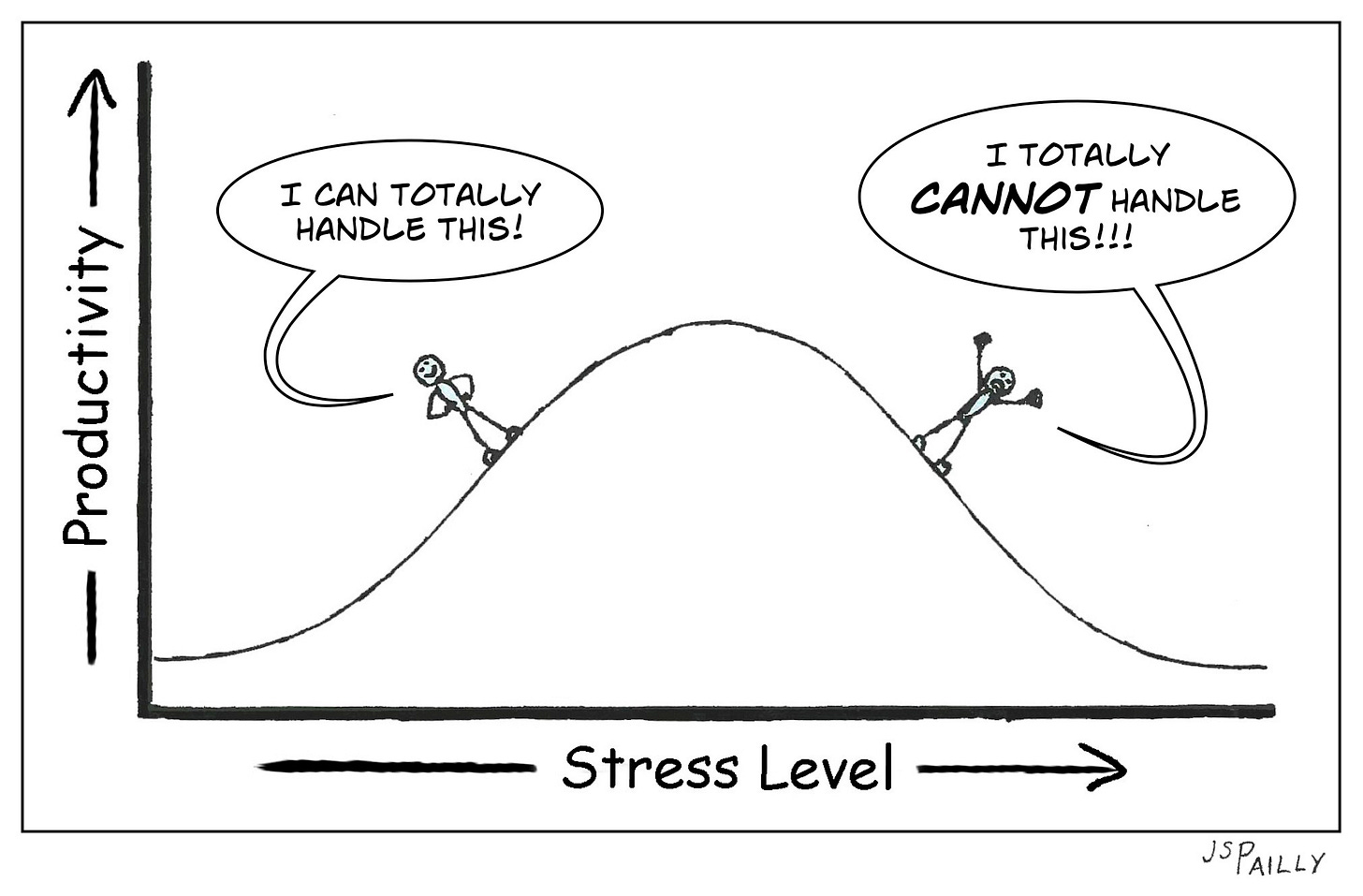TWH#42: Public Speaking In a Nutshell
And how not all stress is created equal.
Recently, one of my clients reached out to me for advice on public speaking. They lead a sizable engineering team at a technology services company, and their role is now becoming more external-facing, which means they have more opportunities to appear in media such as interviews and podcasts, speak at conferences and webinars, etc.
Public speaking can be nerve-wracking. Even having a slot in a company all-hands can be quite stressful. And if you’re not yet experienced with it, all this goes through the roof. I have been a guest in a few podcasts myself, and the experience has not been exactly joyful some of the time. I confess I even feel the anticipation as a little surge of anxiety before many of my 1:1 coaching calls.
This anxiety is actually a good thing… to a point:
The peak of the stress mountain pictured above is where the game’s at. That threshold is what demarcates eustress from distress.
A big part of my role as a coach is helping my clients find and stay as much as possible within the zone of eustress—a state of mindful challenge, where learning and growth happens—and stay away from distress, which leads to the exact opposite outcomes. In fact, chronic (di)stress is a leading indicator of much of the burnout we sadly see in the industry.1
One way I attempt to do this is by making short, 1-page guides available for topics that are core to their activity as product & engineering leaders in complex environments. Think of it as the 20% that gives you the 80% of knowledge you need to be competent in the subject at hand, enabling you to spend more time in eustress and less in distress.
This week I’m sharing here one such guide, leveraging my client’s request for support in the domain of public speaking.
The 80/20 of Public Speaking
Practice and prepare as much as possible. Preparation doesn’t guarantee everything will go well—it gives you the self-confidence that you will be able to deal with the unexpected because your mind won’t have to be focusing so much on the material.
Play exhibition matches. Let go of ego and deliver your rough content to people you trust and who care about you. Having a real human staring at you is enough to put you into real practice mode. The more rounds you put in, the more you hone your message and delivery.
Clarify who your audience is and why you are speaking to them. Make the message relevant to them, not just to you.
Take deep breaths regularly. Deep breathing activates the parasympathetic nervous system, and tells your body there is no real threat. This helps you relax, and you can use it at any moment.
Embrace the nervousness. Reframe anxiety as excitement and energy. It’s there to help you prepare and make your delivery more engaging, not to sabotage you.
Visualize success. Close your eyes and imagine yourself delivering the talk or interview you’d like to deliver. Visualization is a powerful tool used by top-performers, as it primes the brain to make it a reality by activating the premotor cortex.
Remember the audience is human, too. They want to see you succeed, they are not there to judge you. Most people are mostly thinking of themselves, and they just want to learn something or have a laugh.
Tell stories. We have evolved around the campfire telling stories to each other. People resonate with other people’s uniqueness. Remember that what seems obvious or boring to you is often exciting novelty to someone else.
Reflect & improve. Reframe each time you speak in public as yet another notch in your belt. Take time to kindly review how you did, what to keep, what to discard and what to do better next time. 1% better every time.
I’m curious what worked for you. How do you deal with public speaking? Let us know in the comments. 🙂
Yerbo makes available an excellent burnout assessment tool for you and your team. They have also produced a detailed report of the state of burnout in tech last year.



